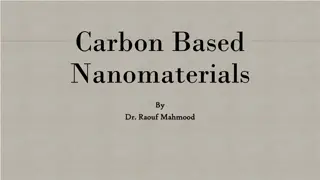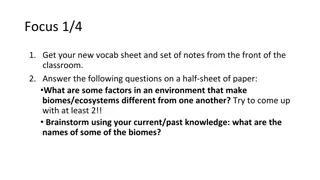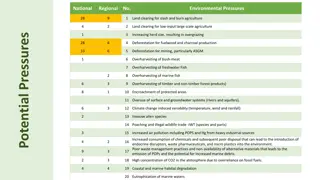Understanding Carbon Storage in Biomes and Ecosystems
Explore the intricate carbon cycle within terrestrial ecosystems, focusing on carbon storage in biomass, litter, and soil. Delve into the differences in plant characteristics among various biomes and their impact on carbon sequestration. Gain insights into the distribution of tropical rainforests and temperate grasslands, shedding light on the biomass and carbon stored in these vital ecosystems. Uncover the unique layers of vegetation in tropical rainforests and the role they play in carbon storage.
Download Presentation

Please find below an Image/Link to download the presentation.
The content on the website is provided AS IS for your information and personal use only. It may not be sold, licensed, or shared on other websites without obtaining consent from the author. Download presentation by click this link. If you encounter any issues during the download, it is possible that the publisher has removed the file from their server.
E N D
Presentation Transcript
CARBON CYCLE 2: biome storage Biomass Litter Soil We are grateful to Hodder for their permission to use the diagrams in this resource. WJEC Focus Box 3.1.7 Eduqas Focus Box 2.1.7
Carbon Cycle 2 Ecosystem carbon storage When human activity is taken into account, the total amount of carbon stored in the terrestrial biosphere is estimated to be approximately 3,000 GtC Carbon is an essential plant macronutrient and makes up approximately 44 per cent of the dry weight of plant biomass Organic carbon is stored in the biomass, leaf litter and soil of terrestrial ecosystems and biomes Class activity Using prior knowledge, discuss the varying plant characteristics of different biomes, and the implications of this for carbon storage
Carbon Cycle 2 Ecosystem carbon storage Green plants Nearly 20 per cent of carbon in Earth s biosphere is stored in plants, including root systems Animals These play a small role in carbon storage because the biomass of animals is much less than plant biomass Litter This is fresh and un-decomposed plant debris; it includes leaves, pine needles and twigs Humus is a black substance that remains in the soil after most of the organic litter has decomposed; it gets dispersed throughout the soil by earthworms Soil Class activity Why is the biomass (and carbon storage) of animals much smaller than the plant biomass in an ecosystem?
Carbon Cycle 2 Global biomes (c) Hodder Education [AQA A-level Geography (Skinner)] Class activity Describe and explain the distribution of (1) tropical rainforest (2) temperate grassland
Carbon Cycle 2 Tropical rainforest (1) Rainforest NPP averages around 2500 grams per square metre per year, and the biomass is 700 tonnes per hectare; this reflects optimum climatic conditions In total, 550 GtC is stored in tropical rainforest biomass and soil Large forest trees store 180 tonnes of carbon per hectare above ground and 40 tonnes of carbon per hectare in their roots Class activity The tropical rainforest has five layers of vegetation. What are the characteristics of these layers?
Carbon Cycle 2 Tropical rainforest (2) Class activity The diagram shows the proportional size of carbon stores in the tropical rainforest; describe and explain the differences shown Biomass Soil Litter
Carbon Cycle 2 Temperate grassland (1) The lack of rainfall is a major limiting factor preventing the growth of thick forest cover. Instead, short perennial (long-lived) grasses dominates the landscape In total, 185 GtC is stored in temperate grassland biomass and soil; temperate grassland typically stores 2-10 tonnes of carbon per hectare above ground and double this amount is stored below ground as roots The soil carbon store (consisting of humus, as opposed to living roots) averages around 100-200 tonnes of carbon per hectare Class activity Research task: what are the main characteristics of the vegetation in temperate grassland world regions?
Carbon Cycle 2 Temperate grassland (2) Class activity The diagram shows the proportional size of carbon stores in the temperate grassland; describe and explain the differences shown Biomass Soil Litter
Carbon Cycle 2 Deforestation and carbon storage Huge areas of Amazonia have been cleared for commercial agriculture: deforestation averaged around 17,500 km2 per year 1970 -2013 Major crops such as soya beans are grown on old rainforest soils in Brazil; the biomass of soya crop cover is 2.7 tonnes per hectare compared with 180 tonnes per hectare for virgin rainforest Oil palm cultivation takes place at the expense of tropical rainforest cover. Class activity What are the implications of rainforest removal for the operation of different carbon stores and flows?
Carbon Cycle 2 Deforestation and carbon storage Class activity The diagram shows the proportional change in carbon stores and flows following rainforest removal. Describe and explain the changes shown (c) Hodder Education [AQA A-level Geography (Skinner)]
Carbon Cycle 2 Afforestation and carbon storage New trees act as carbon sinks and can therefore help with climate change mitigation New monoculture of commercial trees, such as coniferous plantations in the UK, can increase carbon storage if it replaces grassland However, plantations store less carbon than natural forest because monoculture forest lacks biodiversity and provides few habitats for other species Class activity Who could carry out afforestation? Think of different scales of action, from citizens to governments
Carbon Cycle 2 Agriculture and carbon storage Clearing natural vegetation for agriculture brings a large reduction in carbon storage; in many farmed areas, soil carbon levels have fallen by 50 per cent Soil erosion occurred in the USA during the 1920s and 1930s . In the Great Plains, wind erosion stripped the top soil from 65 million hectares of over-cultivated land, leading to an enormous loss of soil carbon storage capacity Class activity What techniques could farmers use to improve carbon storage? Think of irrigation, fertilisers or other actions
Carbon Cycle 2 Plenary Carbon storage varies between biomes Climatic controls including temperature, precipitation and light are responsible for the large biomass carbon store in tropical rainforest and the large soil carbon store in temperate grassland Deforestation has been occurring for thousands of years and has reduced carbon storage at both national and global scales Afforestation can help with climate change mitigation by increasing carbon sequestration and storage Agriculture has both negative and positive effects on carbon storage and flows























